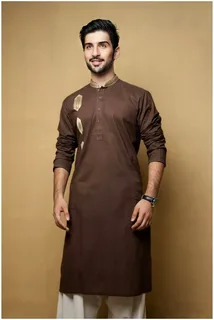The Timeless Elegance of Shalwar Kameez
The shalwar kameez stands as one of the most iconic and versatile outfits, deeply rooted in the cultural heritage of South Asia. This traditional attire has not only transcended time but has also adapted to modern fashion trends while preserving its cultural significance. With its two main components—the shalwar, a pair of loose trousers, and the kameez, a long tunic—the outfit represents comfort, elegance, and adaptability. The shalwar kameez is a staple in countries like Pakistan, India, and Bangladesh and is celebrated globally for its beauty and functionality.
A Historical Perspective
The origins of the shalwar kameez can be traced back to the Mughal era, where it was introduced as a practical yet regal outfit. Initially worn by the nobility, its popularity quickly spread among the general population. Over the centuries, the attire has evolved, incorporating regional influences and adapting to the changing times.
The Mughal legacy is evident in the intricate embroidery, luxurious fabrics, and elaborate designs often associated with the shalwar kameez. Despite its evolution, the outfit has retained its cultural roots and remains a symbol of tradition and identity in South Asia.
Key Features of Shalwar Kameez
1. Comfort and Practicality
One of the most appealing aspects of the shalwar kameez is its comfort. The loose-fitting shalwar allows for ease of movement, while the flowing kameez ensures breathability. This makes it an ideal choice for both formal and casual settings, especially in South Asia’s varied climate.
2. Versatility for All Occasions
The shalwar kameez is incredibly versatile, suitable for a wide range of events and occasions.
- Casual Wear: Light fabrics like cotton or lawn are commonly used for everyday wear.
- Formal Attire: Heavier fabrics like silk, chiffon, and velvet, often embellished with embroidery, are preferred for weddings, religious ceremonies, and festive occasions.
3. Gender-Inclusive Appeal
The shalwar kameez is equally popular among men and women, with variations in styles and designs to suit each gender. Men often wear simpler, more subdued designs, while women have a wide range of vibrant colors, patterns, and embellishments to choose from.
Regional Variations
The shalwar kameez has numerous regional adaptations, reflecting the diverse cultural landscapes of South Asia.
1. Punjabi Shalwar Kameez
Known for its vibrant colors and bold patterns, the Punjabi variation features shorter kameezes paired with pleated or Patiala-style shalwars. It is a staple in Punjab, celebrated for its lively and festive appeal.
2. Sindhi Shalwar Kameez
In Sindh, this attire often includes intricate mirror work and embroidery, showcasing the rich artisanal heritage of the region.
3. Pathani Suit
A popular variation among men, the Pathani suit features a straight-cut design with minimal embellishments. It is particularly popular in Khyber Pakhtunkhwa and neighboring regions.
4. Modern Styles
Contemporary designers have reimagined the shalwar kameez, introducing fitted silhouettes, asymmetrical cuts, and fusion elements that appeal to younger generations.
Cultural Significance
The shalwar kameez is more than just an outfit—it is a cultural symbol that reflects the values, traditions, and identity of South Asia.
1. Celebration of Heritage
Wearing a shalwar kameez is often seen as a mark of respect for tradition. It is a popular choice for religious and cultural events, such as Eid, Diwali, and weddings, where people dress in their finest, often embellished, versions of the outfit.
2. Modesty and Grace
The outfit is widely appreciated for its modesty, making it a preferred choice in conservative and religious settings. It strikes a perfect balance between elegance and simplicity.
3. Global Representation
For South Asians living abroad, the shalwar kameez serves as a connection to their roots. It is worn with pride to showcase cultural identity and heritage in multicultural environments.
Modern Adaptations and Fashion Trends
The shalwar kameez has kept pace with global fashion trends, making it a favorite on international runways. Designers have introduced contemporary twists, such as pairing a kameez with jeans or styling a shalwar with a Western blouse. These fusion styles cater to a broader audience, making the attire more accessible and appealing to fashion enthusiasts worldwide.
Additionally, digital printing, laser-cut patterns, and innovative fabrics have added a modern edge to this timeless outfit, ensuring its relevance for generations to come.
Styling the Shalwar Kameez
- Fabrics Matter: Choose breathable materials like cotton for daily wear and luxurious fabrics like silk for formal events.
- Accessorize Smartly: Add traditional jewelry, embroidered footwear, or a matching dupatta to enhance your look.
- Tailored Fit: A well-fitted shalwar kameez elevates your overall appearance.
- Experiment with Colors and Patterns: Don’t shy away from vibrant hues and bold designs—they add personality to your outfit.
The Appeal of Shalwar Kameez for Men
Men’s shalwar kameez designs are often understated yet sophisticated. Neutral tones, subtle embroidery, and tailored fits make it a classic choice for formal occasions like weddings and religious gatherings. The simplicity of the attire allows for versatility, making it a wardrobe essential for South Asian men.
The Timeless Allure for Women
Women’s shalwar kameez comes in endless styles, from heavily embroidered bridal wear to minimalist designs for daily use. The addition of a dupatta adds elegance and offers endless styling possibilities, further enhancing its charm.
Conclusion
The shalwar kameez is a timeless garment that beautifully marries tradition and modernity. Its adaptability, cultural significance, and unparalleled comfort make it a cherished outfit across generations.
Whether worn casually or for grand celebrations, the shalwar kameez continues to represent the rich cultural tapestry of South Asia. It is more than just clothing—it is a celebration of heritage, a symbol of identity, and a testament to the enduring legacy of South Asian culture.
4o

